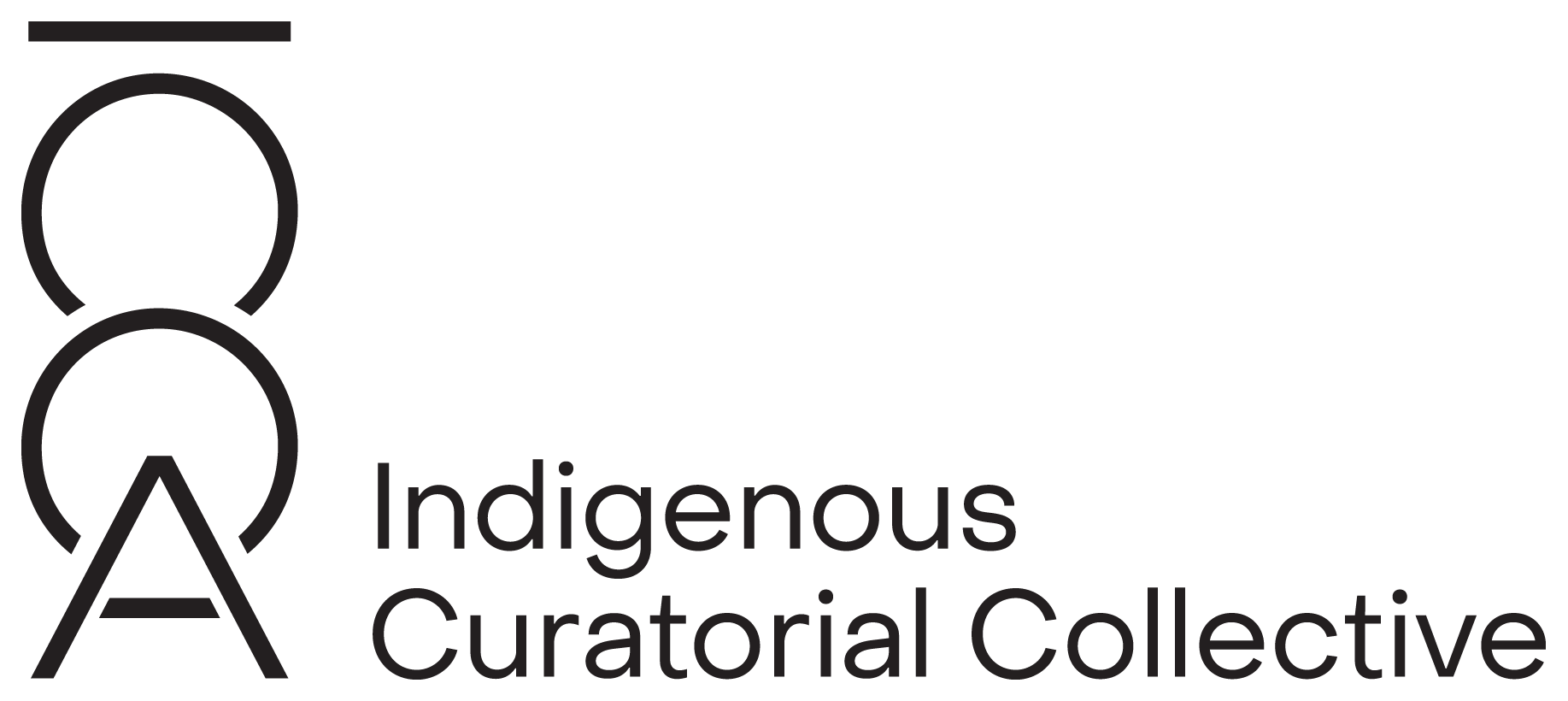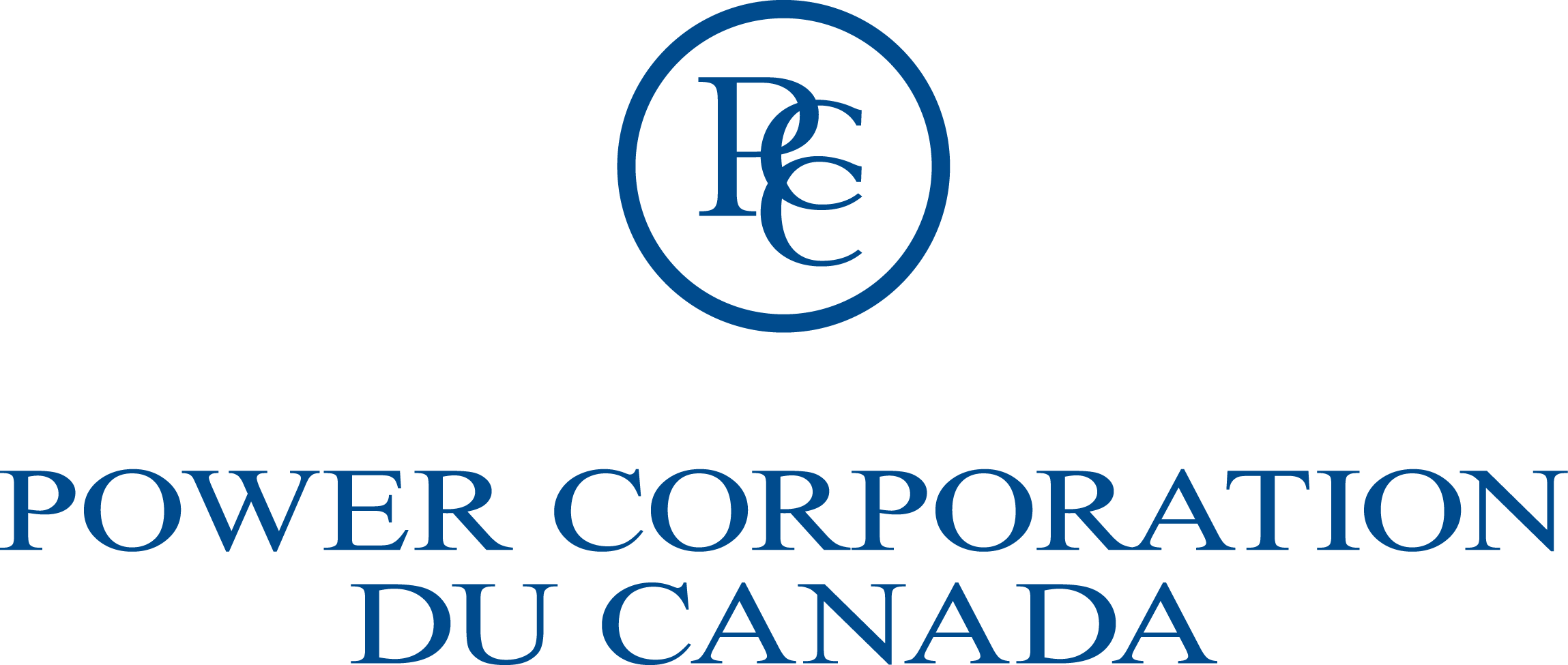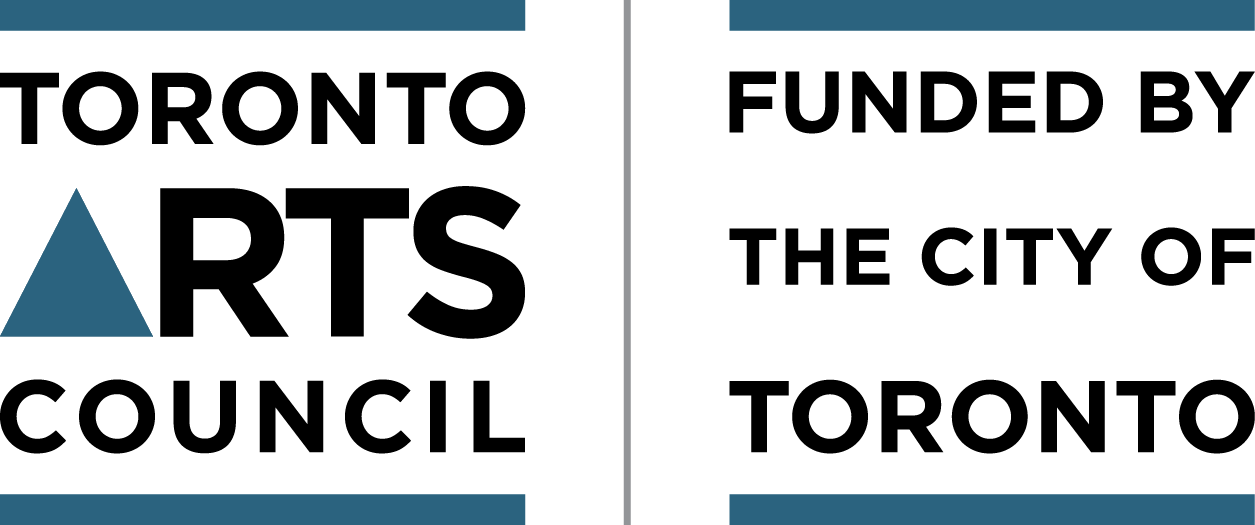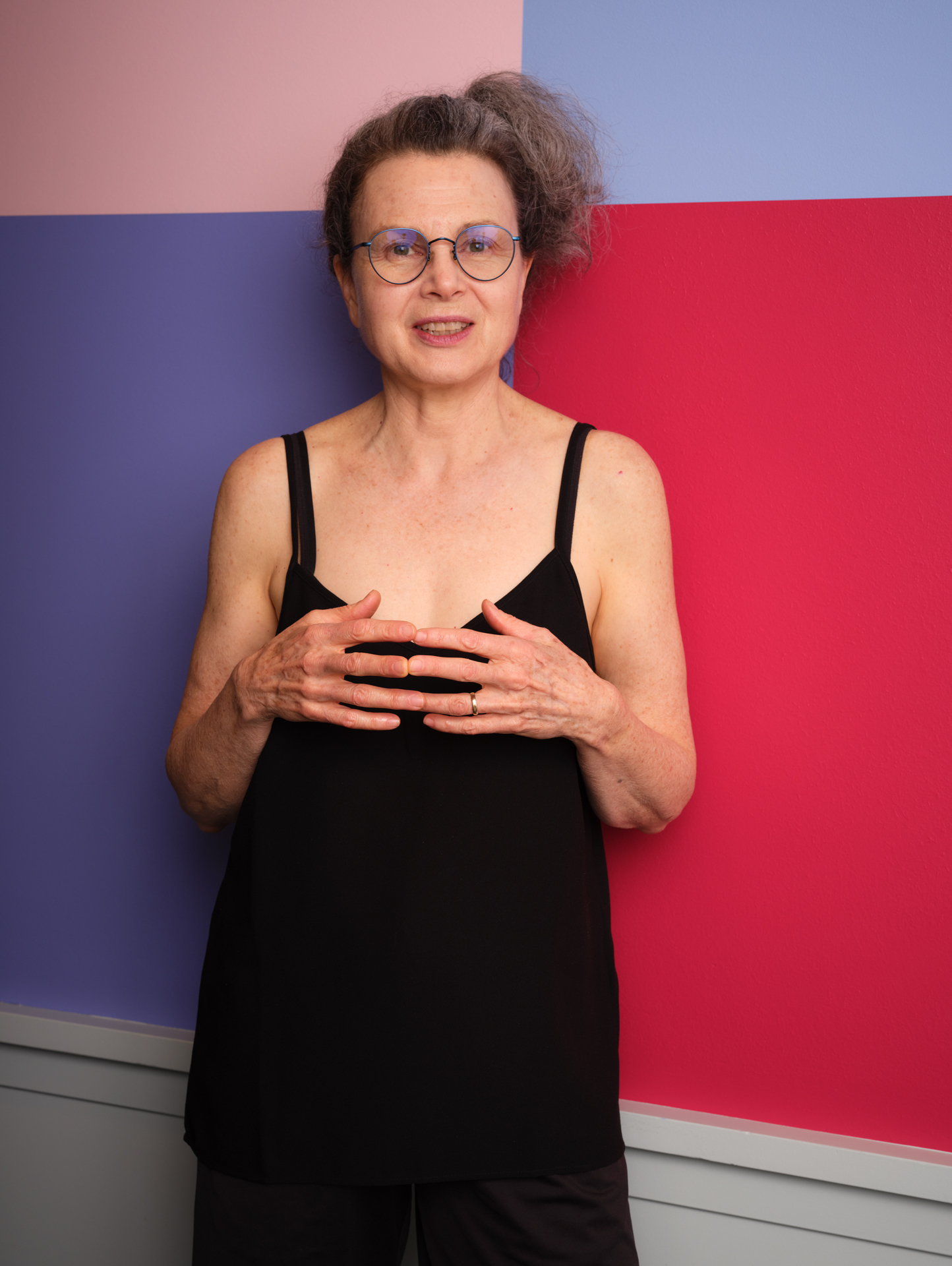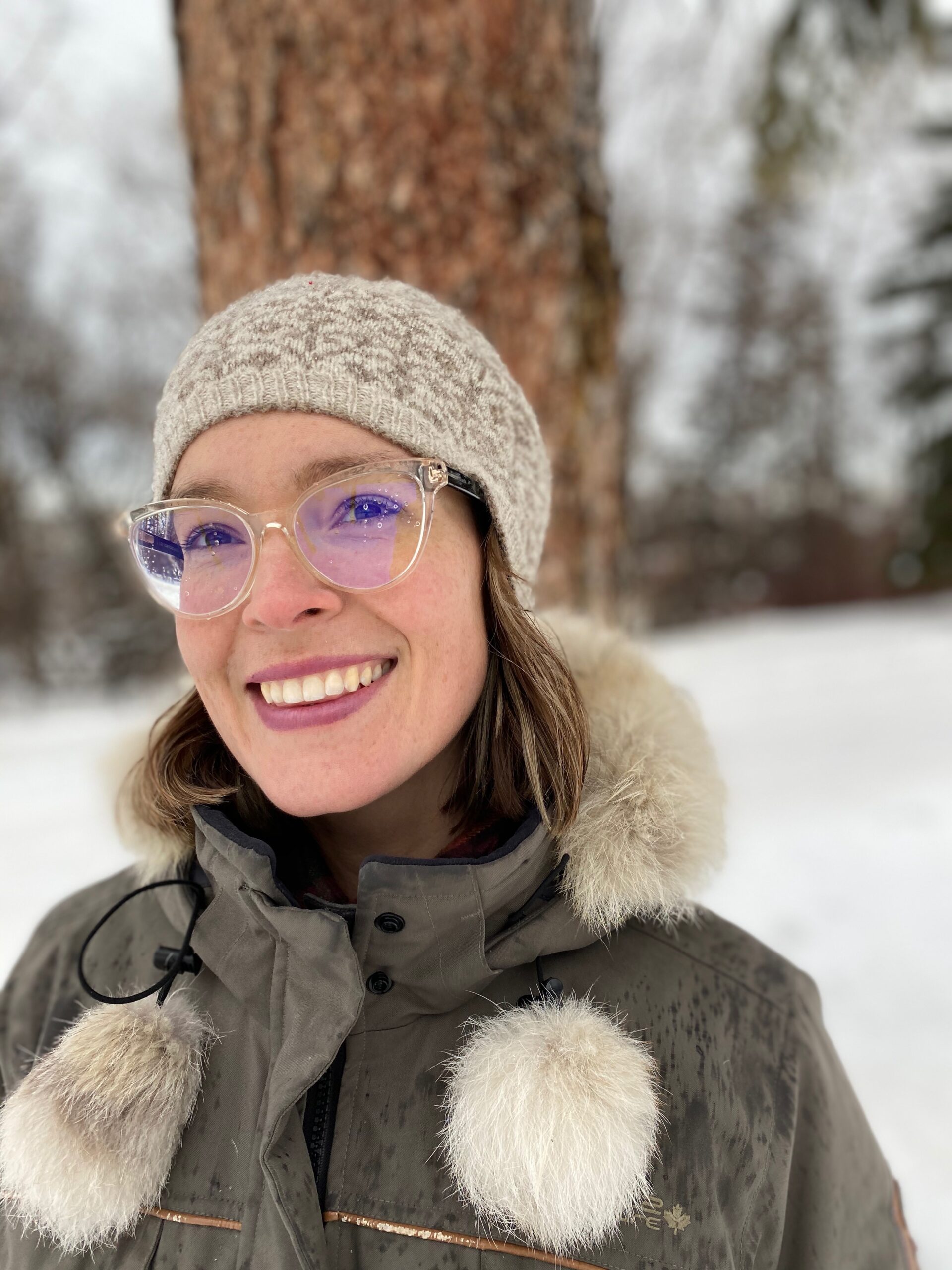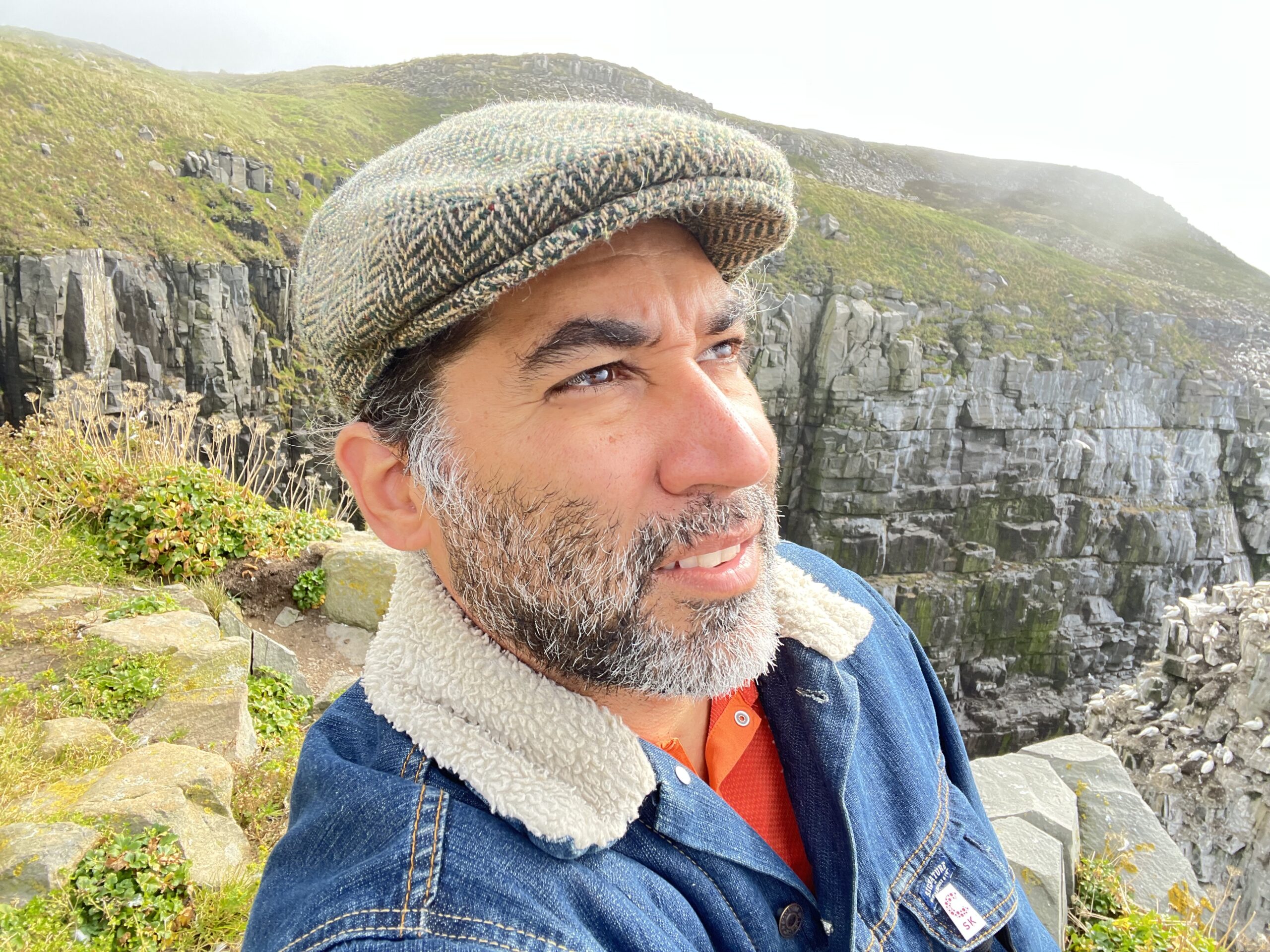Reaching Inwards
A Collection of Responses to Issues in Art, Curation and Community Care Roundtable Series
FR
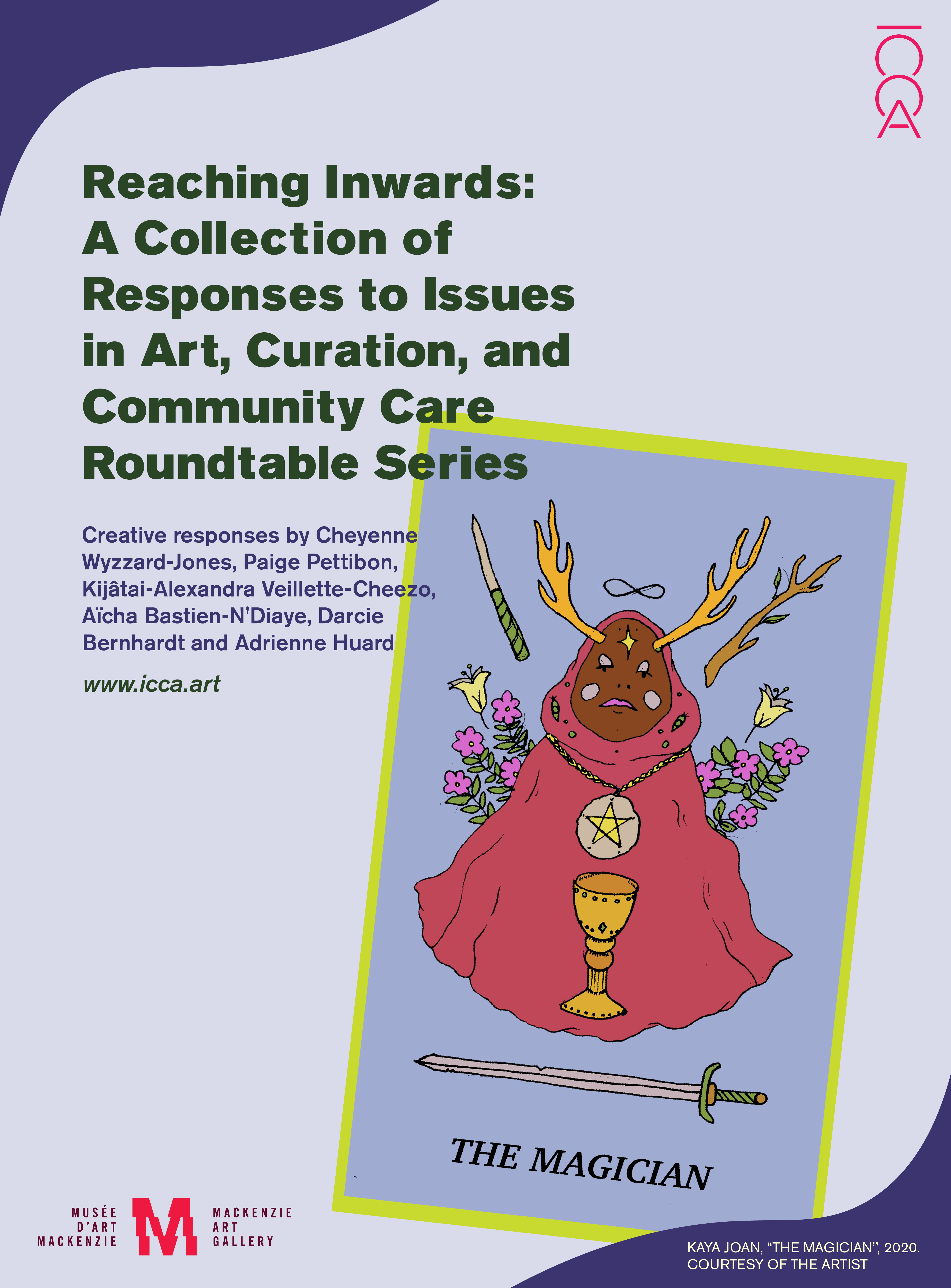
In 2021 the ICCA programmed four closed roundtables to take place amongst Indigenous communities that are often neglected from the National discourse on Indigenous arts, curation, and community care. The “Issues In…” series explored the nuance and pluralism within the ICCA’s membership as well as the diversity within Indigenous communities across what is currently known as Canada, spotlighting Afro-Indigenous, Northern, Francophone, Queer and 2Spirit voices. You can watch the roundtables on our Vimeo account if you click here. The transcripts are available on demand.
Six months after the roundtables were held, the Mackenzie Art Gallery generously donated funds to the ICCA to support the continuation of the “Issues In…” series, allowing artists and writers from the highlighted communities to create new works in response to the roundtables.
Please find below six incredible responses created by Cheyenne Wyzzard-Jones, Paige Pettibon, Darcie Bernhardt, Aïcha Bastien-N’Diaye, Kijâtai-Alexandra Veillette-Cheezo, and Adrienne Huard.
Black & Indigenous Perspectives
Responses to the first roundtable on Black & Indigenous Perspectives from the series Issues in Art, Curation and Community Cares featuring participants Nenookaasi, Shanese Anne Indoowaaboo Steele, Aria Evans, kaya joan, Teineisha Richards, and Lena Farrell.
Responses by Paige Pettibon and Cheyenne Wyzzard-Jones below.
Paige Pettibon
Work of Healing
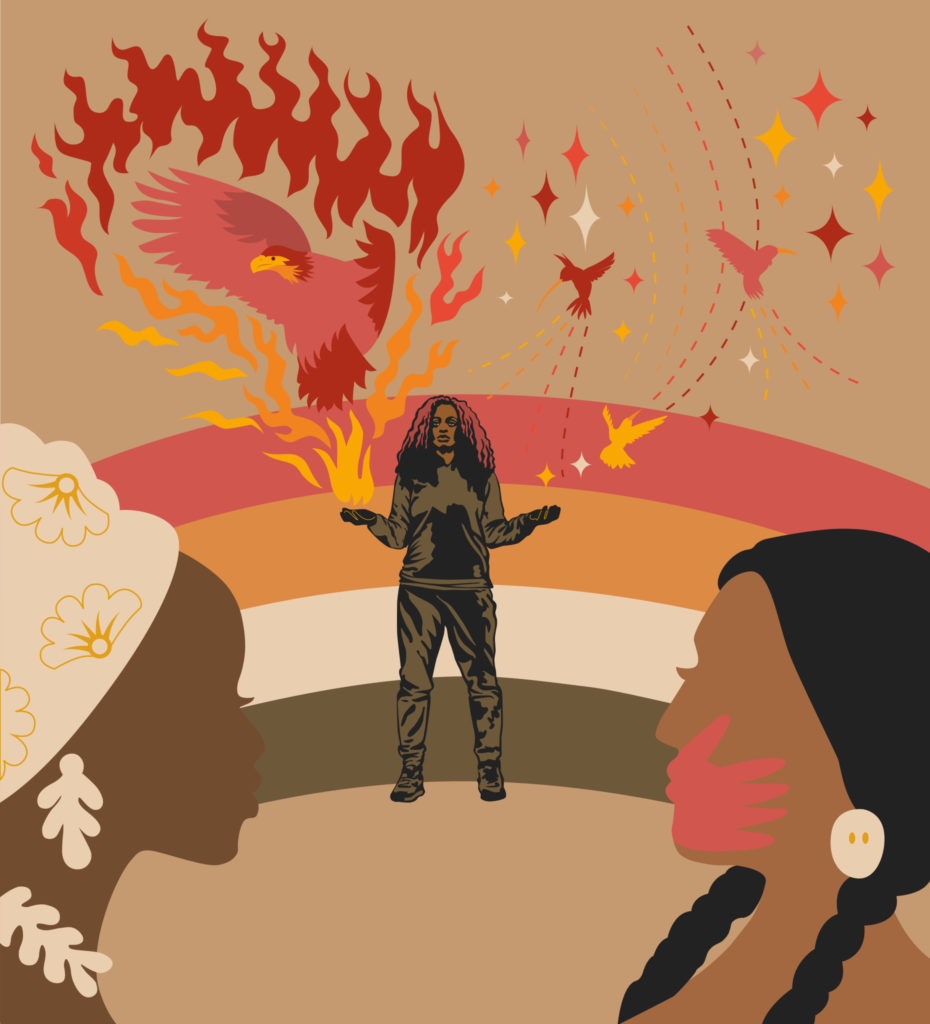
Paige Pettibon
White, and Salish (from the Confederated Salish and Kootenai Tribes). Paige is influenced by her multicultural background. She identifies as a community artist. She continues to grow within the Indigenous community by learning the Lushootseed language, tribal songs, arts, dances, and traditions.Some of the working projects that keep her busy day to day are her small batch jewelry business titled Plain to Sea. Her contract with the Muckleshoot Tribal school’s curriculum development department to create specific graphic images focused on indigenous plants, animals, social, and emotional work. Teaching Lushootseed for the Multilingual Institute online.Paige is apart of the yehaw’ show organization cohort and contributes to the administration efforts in prioritizing Indigenous art and artists in public spaces. She’s worked with the Smithsonian, Nia Tero’s Reciprocity Project, Starbucks, North Seattle College, Tacoma Community College, the city of Tacoma’s Art Commission, MadArt Gallery, Stonington Gallery, Tacoma Art Museum, Puyallup Tribal Language Department, and a few other Pacific Northwest communities.Her jewelry can be found on Instagram @plain_to_sea and her art @Paige_PettibonHer website is PaigePettibon.com
Cheyenne Wyzzard-Jones
Reflection
Black Indigenous people exist in the in-between. We exist in a world that does not understand, value, or recognize our existence. We are told we must be “full” Native blood to claim Indigeneity, a practice of colonial erasure. We are told if you have one drop of “Black blood” in your body, you can expect to face the violence of anti-Blackness and hyper-visibility, that is unless you are light enough to “pass”. Our realities tell stories of both violent erasure and commodified exposure. Lateral colonial systemic violence has used our bodies, a source of our ancestral form of art, to dictate our narrative. However, panels such as the one curated by the Indigenous Curatorial Collective—an intergenerational gathering of six Black Indigenous artists—reflect not only why our stories are important but how we have always been creating, manifesting, and practicing art and community care as a means of sustainability. When we speak about Black Indigeneity, as Shanese Anne Indoowaaboo Steele mentioned on the panel, it is important to understand that Indigeneity is not exclusive to non-Black people. There are Indigenous people who are Black not because they are mixed-race but because there is a world where Black and Indigenous are simultaneous. There are also our mixed-race relatives, who are Black Indigenous due to a long, shared history of Black and Non-Black Indigenous families loving, caring, and being in solidarity with each other. As a Black Indigenous person who is rooted in my ancestral coastal family of Whalers, who then created family with the Nipmuc and Wampanoag nations, I appreciated Aria Evans sharing the history of the slave trade collide in Nova Scotia. Listening to Elder “Mama” Lena Farell speak about the loneliness of Eldership in Nova Scotia, identifying herself as one of the only people in her community who has gone through traditional ritual to receive the honor of Eldership, speaks to the real consequences of colonial violence in our Black Indigenous communities. It also speaks to what many on the panel shared as the many ways we are paving our own path in both our artistic career and community networks.
As artists, curators, and people who want to exist in a place where everyone is seen, we must be able to expand our mind and practice beyond a single narrative of race and ethnicity. What histories are we silencing? What does it really mean for Black Lives to matter? And who holds us accountable to our responsibility in filling the gaps of our collective societal imagination? Shanese spoke a truth that I believe a lot of Black Indigenous artists face. The fact that people are either interested in an Indigenous perspective or a Black perspective, but rarely both. And when we share the reality of both, we are vulnerable to a wave of anti-Blackness or anti-Indigeneity both within and outside of our communities. Which means any community care must center the question; where do Black Indigenous people feel safe? Safety refers to a sense of belonging, a sense of feeling understood in mind, body, and spirit. However as mentioned in the panel, Black Indigenous people face specific violence when questioning “Am I enough?” Aria spoke to this point when she explained how convincing people they do not belong to their own communities and cultural groups is an effective tool of colonization. “This is a method of separation that we have witnessed as a repetitive tactic from colonizers.” I appreciated the conversation on settler colonialism, as being Black on Turtle Island informs a skeptical perspective on reconciliation. The reality is that while Black people are fighting to be seen as contributors in a country we built, the root issue is being seen as less than human. There is a continuous cycle of commodification of Black bodies for a colonized economy. It is also important to mention here that this reflection about Black Indigenous perspectives on settler colonialism is a whole other topic within itself. I mentioned this because when discussing issues within the art industry and community organizing, the question about where we receive resources from and what compromises we are making to receive them comes into question. It is again a question of who is being center and who is being neglected.
Like any racial or ethnic group, Black Indigenous people do not exist within a monolith. Our experiences are vast and complex. It is also important to note that what I appreciated about this panel is that many identified as queer, non-binary, and/or two/multiple spirited folks. This brought its own uniqueness to the way the panelists understood their reality within their communities and their artistic practice. As a queer person who uses she/they pronouns, I want to expand the importance of Kaya Joan’s response when they said they see their work as a space of reclamation, abundance, and joy. That sounds like the queerest, Blackest, and most Indigenous reason to create art that I could ask for. Within my own queerness, I have seen my Indigeneity be synonymous with my practice and rituals with the land, my body, and my community. It is one that does not see spiritual beings, Land, and those who stewarded it, within a binary. I explained this in one of my first writings on Black Indigeneity that “my gender is Black.” I stated, “to claim this is an act of understanding how colonialism and slavery have dehumanized Black [and Indigenous] gender expression as ‘always done wrong, done dysfunctionally, done in a way that is not normal.’ To claim [my gender as black] is to understand how policing Blackness and gender are interconnected.” Therefore, for Black Indigenous art to be a space for reclamation, a space to share abundant truth, is a radical act. I hope that we can create more spaces for Black Indigenous narratives to be shared, valued, and honored in a way that moves our world towards real liberation. Art is a means to shift culture and consciousness, and we must center the most vulnerable and the most neglected if we truly believe creating and curating art can be a radical political act.
Cheyenne Wyzzard-Jones
Cheyenne Wyzzard-Jones is Co-Founder of the collective In Solidarity (previously Women of Color in Solidarity) and Creative Director for Spiritual is Political. Through the mediums of radical teaching, community organizing, and art making, Cheyenne explores the expansiveness of freedom building. They are currently based in Lenape Land, Philadelphia, PA and have been consistently organizing throughout the United States, Canada, and the Caribbean for over 10 years. Their work is deeply grounded in and informed by Black Indigenous Feminist Queer thought and praxis. It is rooted in technologies that disrupt white patriarchal dominant structures of time, gender, borders, and extreme systems of punishment that have altered natural order. Their work has been featured on TEDx, The Void Academy, CRWN Magazine, Medium Magazine, and The Queens Museum.
Northern Perspectives
Response by Darcie Bernhardt to the roundtable on Northern Perspectives from the series Issues in Art, Curation and Community Cares featuring participants Ossie Michelin, Taqralik Partridge, Teresa Vander Meer-Chassé, Bryan Winters, Jessica Kotierk, Elder Naulaq LeDrew, and Tamika Knutson
Darcie Bernhardt
Jijuu’s Shoes
Memory has a huge impact on my practice and inspiration as a way of decolonial preservation. I kept thinking about how leaving my community and remembering slipper patterns have been passed down. Leaving an imprint and relearning how to make floral designs is something I was able to reconnect myself to home. What I held on the roundtable of the Northern Perspective was hearing and remembering to be in community with Inuit and Indigenous folks.
The Jijuu’s Shoes series includes 9 small drawings and a short video by Darcie Bernhardt. The drawings are floral designs used for slipper patterns. Each set of drawings includes a drawing of the floral design traced with black pencil, a drawing of the floral design traced with color pencils over the black pencil, and a drawing of the floral design with color fill. The three types of floral designs include a dark and pale red flower with green leaves; a dark red flower with blue and purple colors in the petals and green and yellow leaves; and a dark and pale blue flower with green leaves. The video is 12 seconds long. We see Darcie’s hands turning a few pages of their little sketchbook and there is a drawing of a flower on each page.

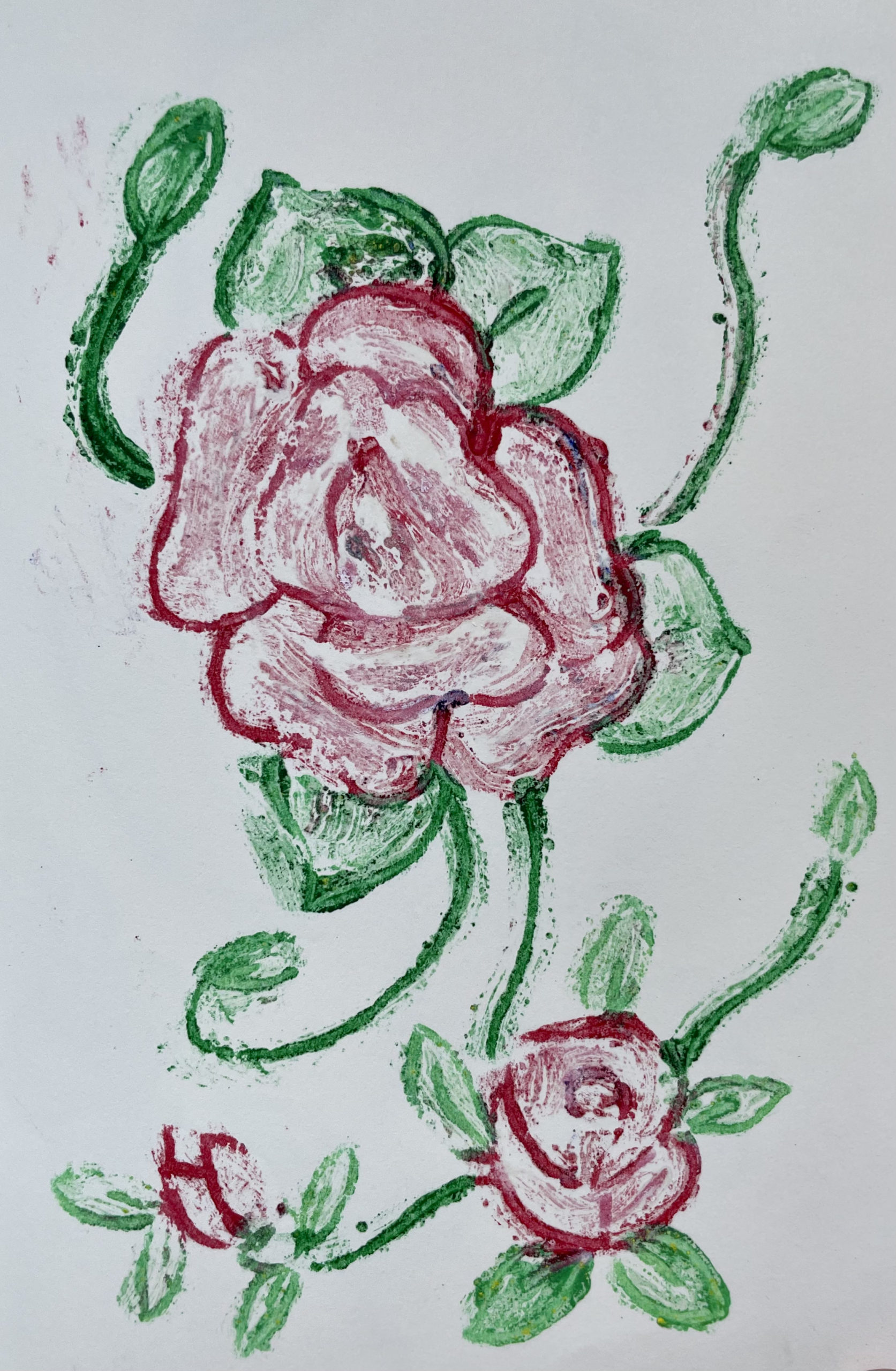
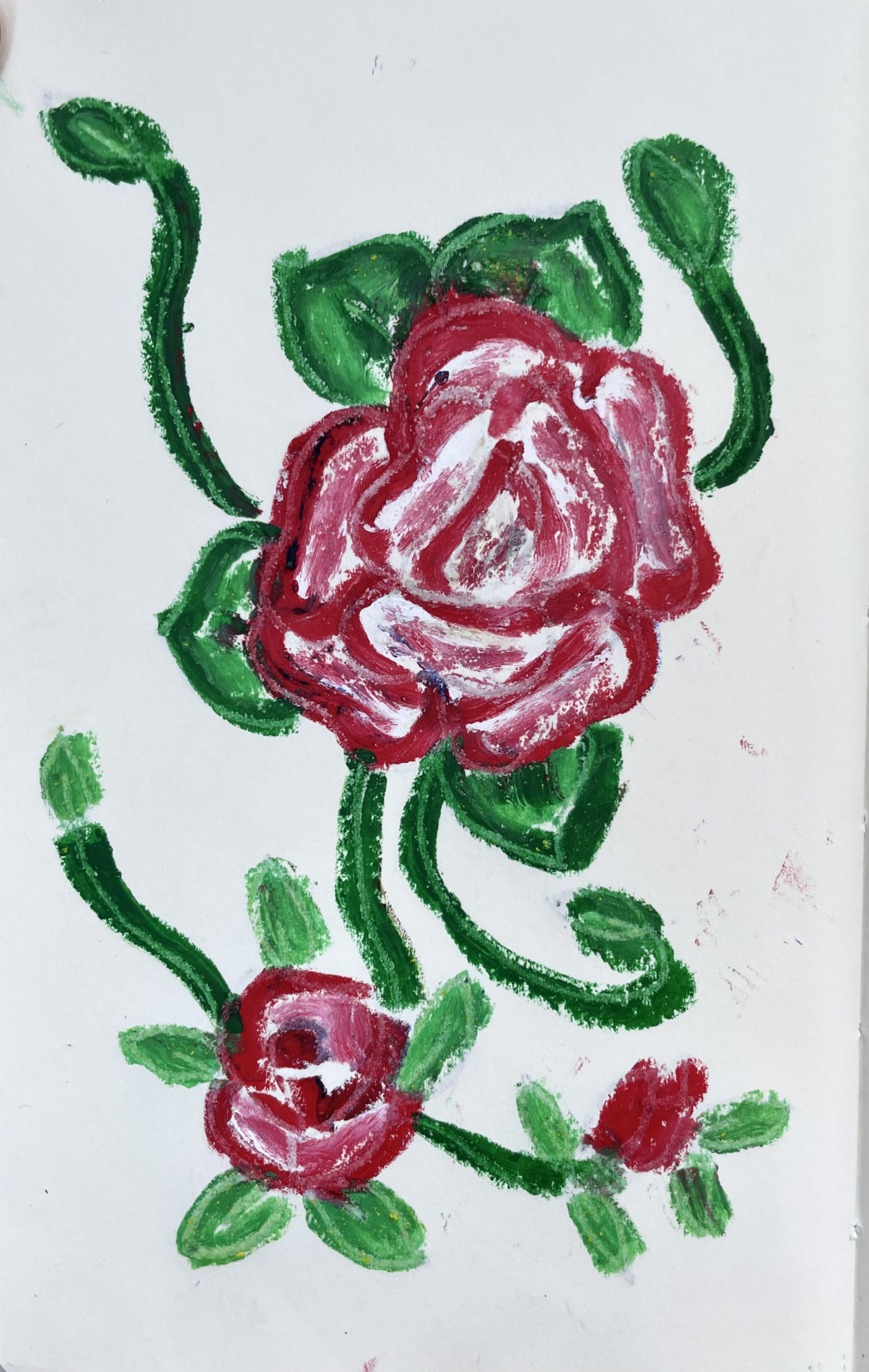
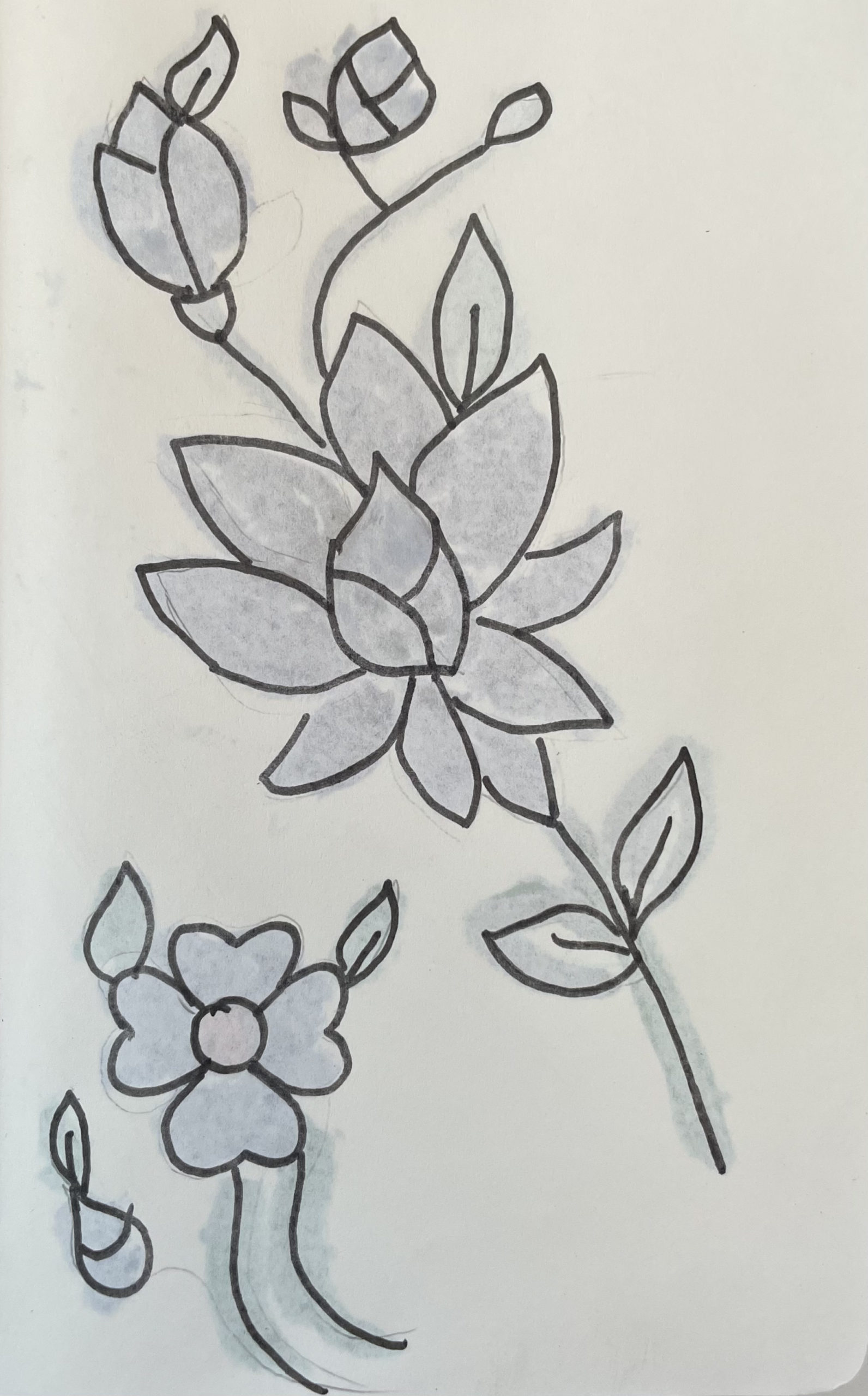
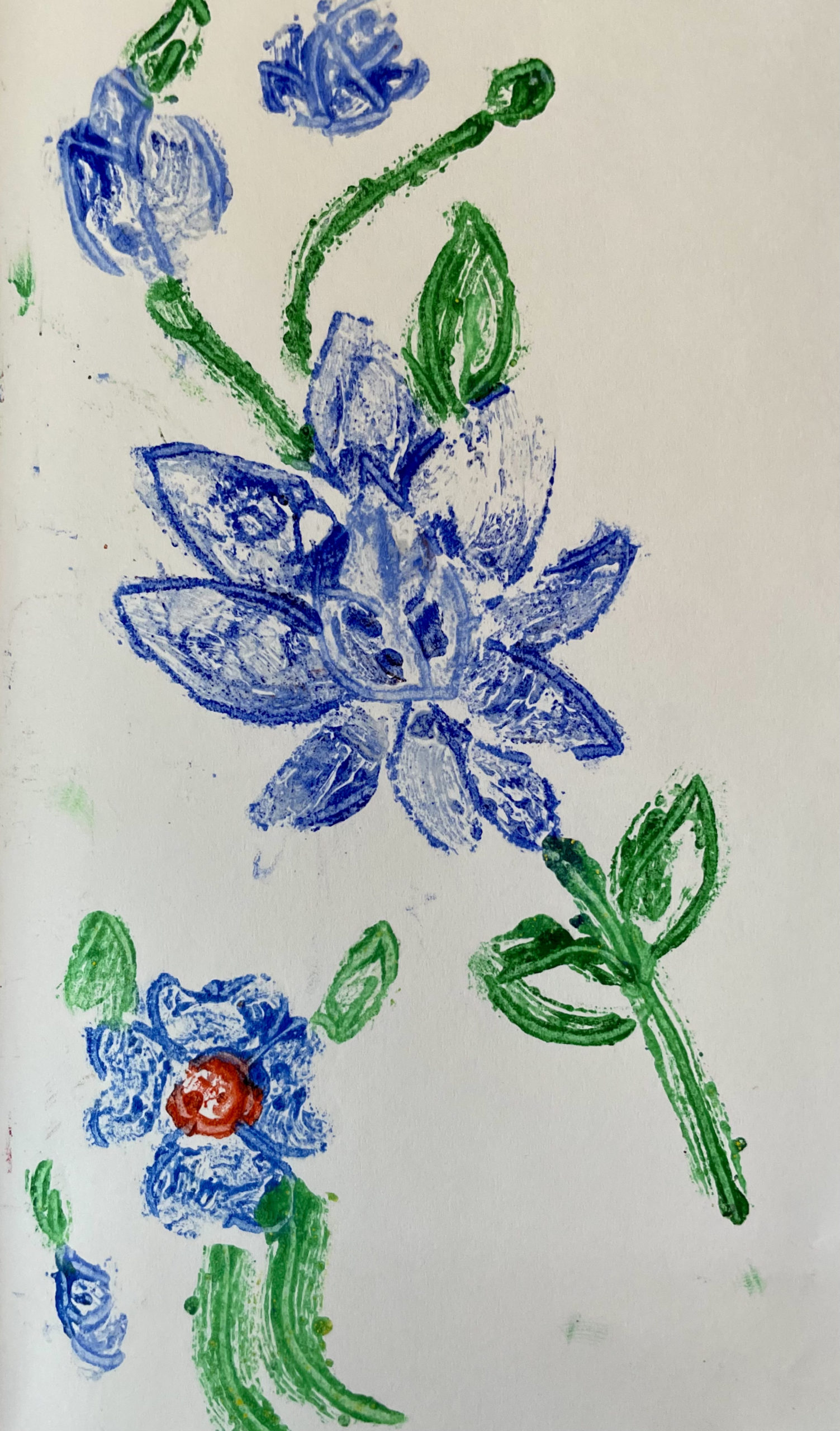
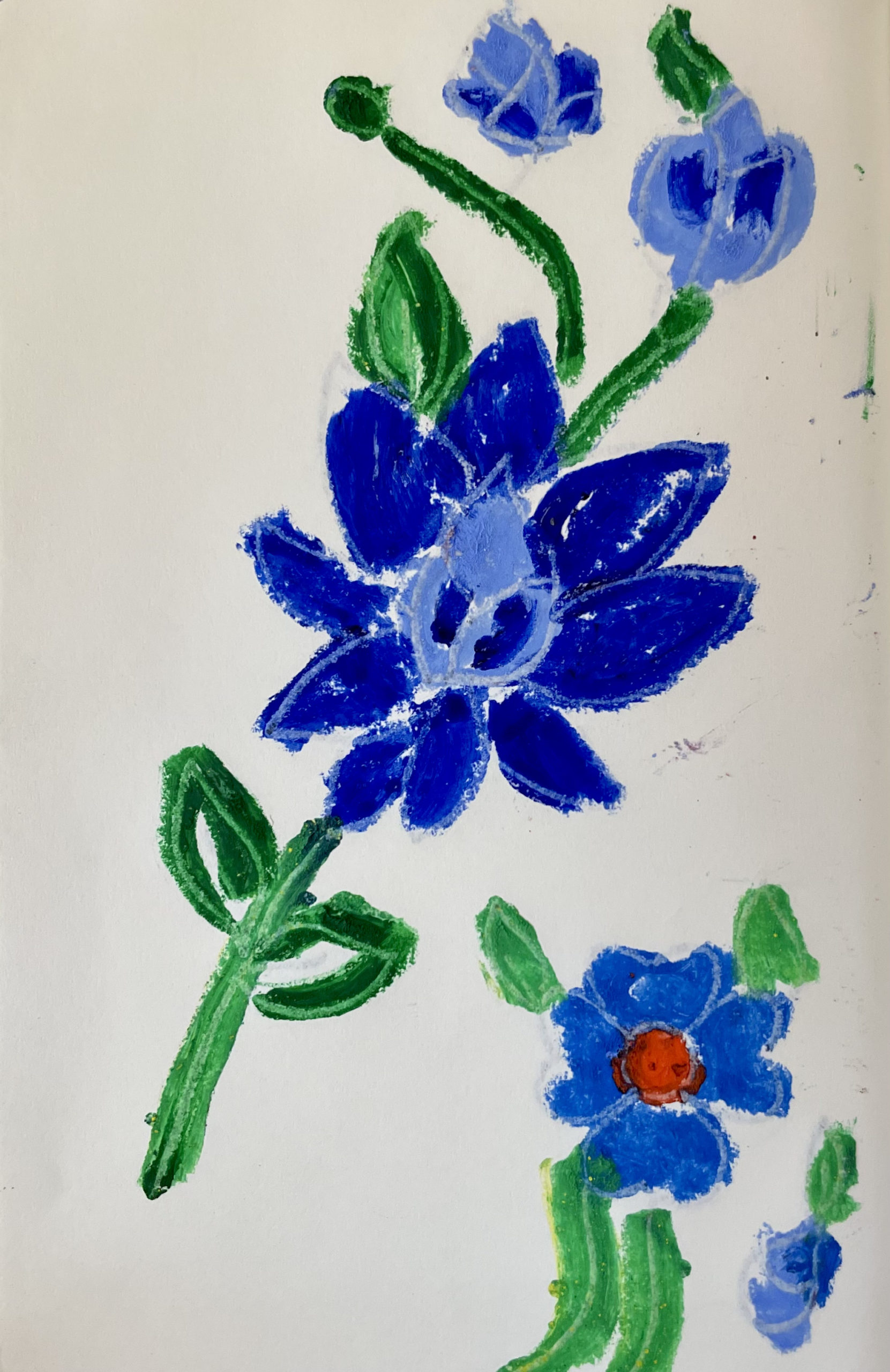
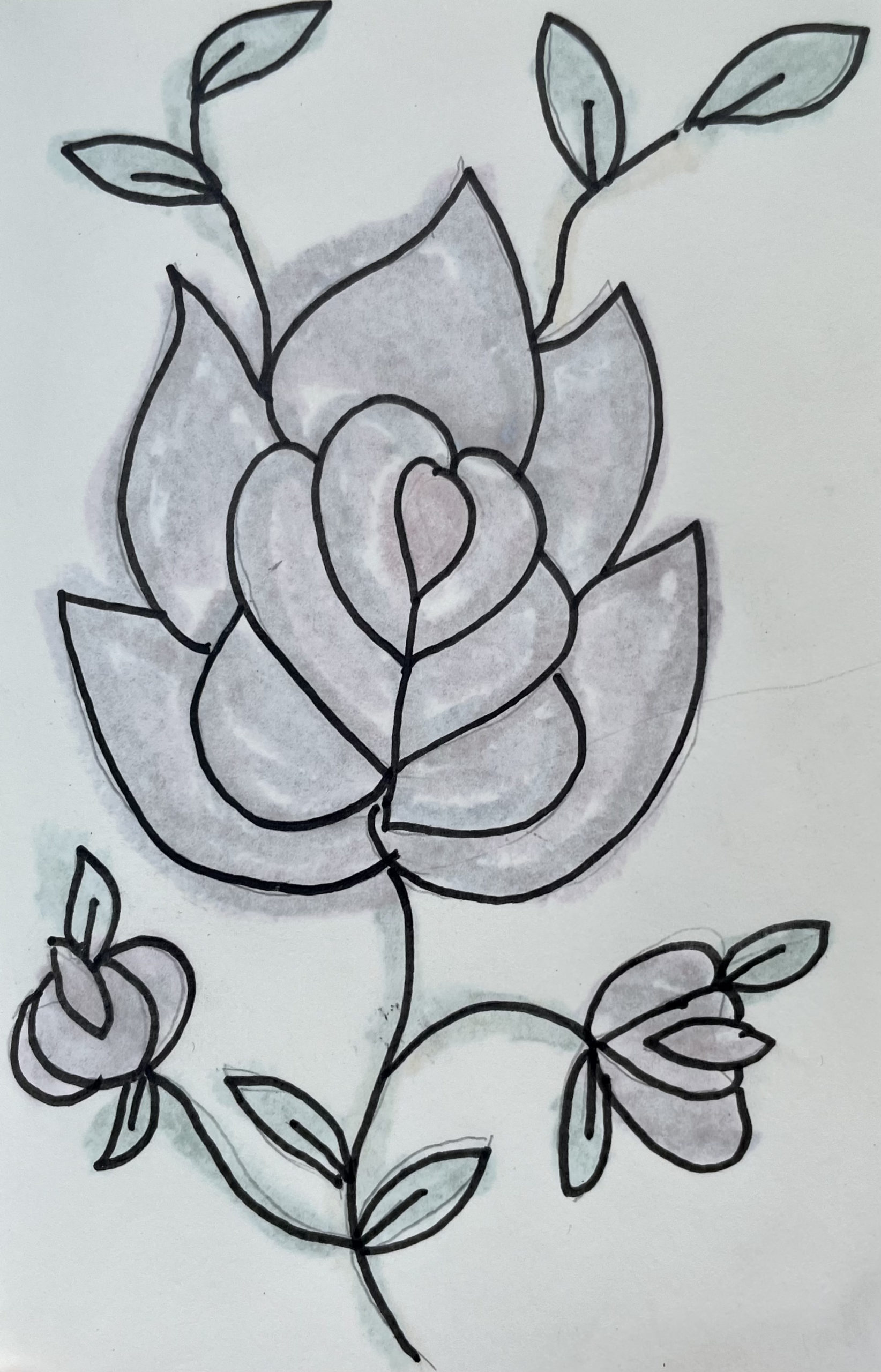
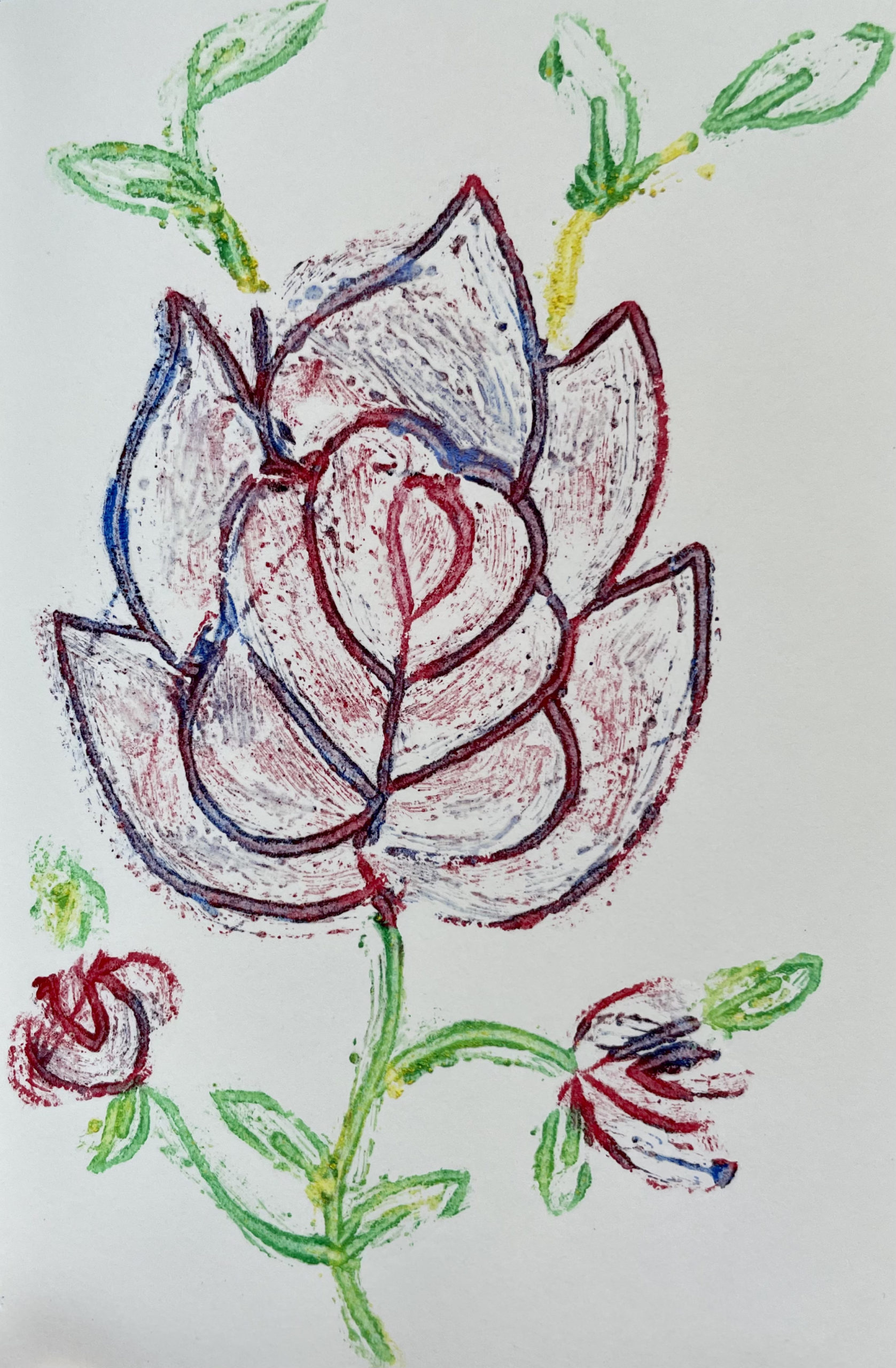
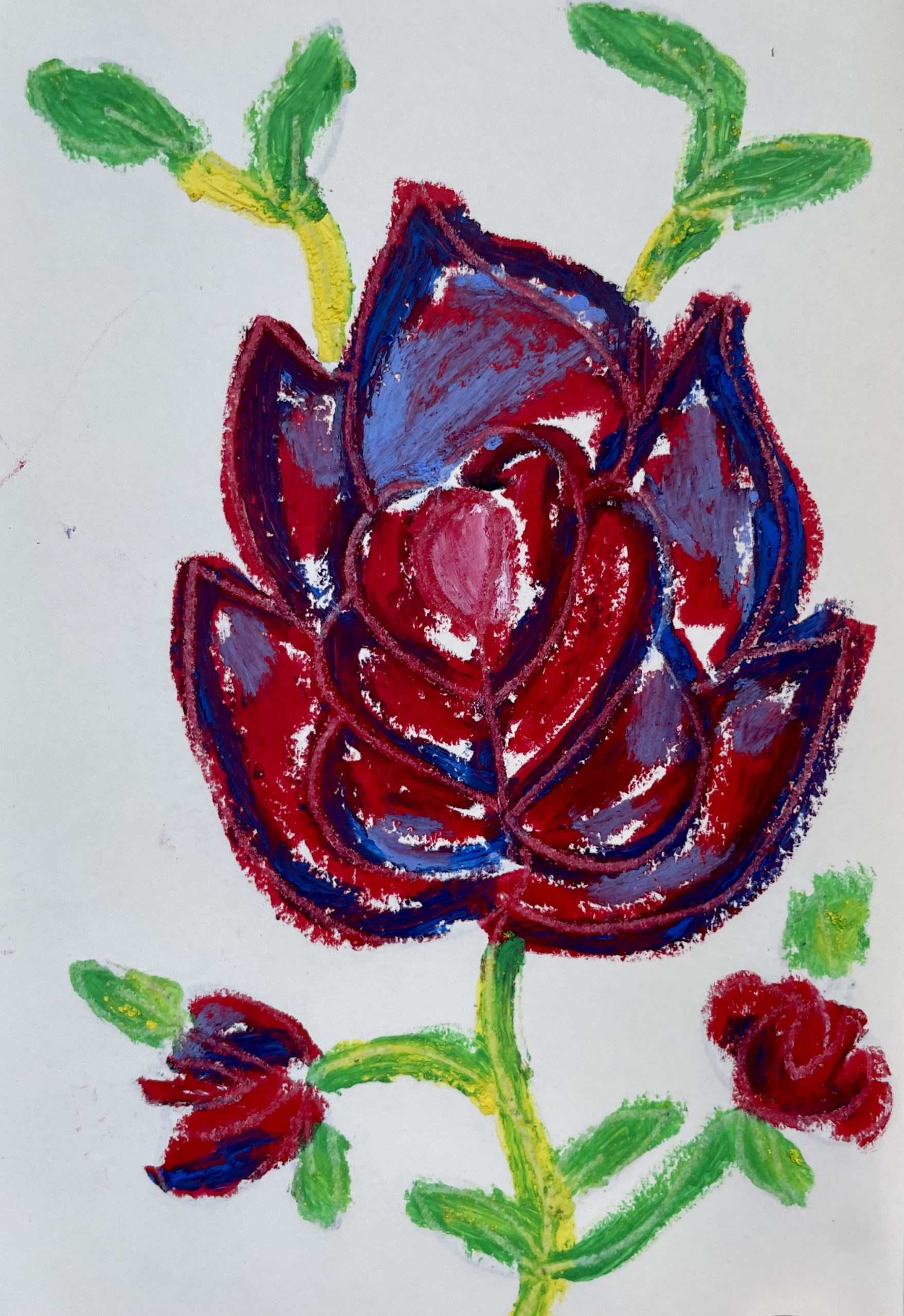
Darcie Bernhardt
Darcie “Ouiyaghasiak” Bernhardt is an Inuvialuk/Gwichin artist from Tuktuyaaqtuuq, NT, Alumna of NSCADU in 2019 (BFA). Raised in Tuktoyaktuk where the ocean’s harsh winds carve into the Western Arctic landscape. Bernhardt has a special bond created from this ecosystem to their family and sense of place. Their practice has primarily focused on the narrative of domestic life in the North stemming from memories of home. Their first painting solo show titled Akisuktuaq was shown at Feheley Fine Art gallery this June (2021). They were a part of EVERYSEEKER’s Call + Response where they created video animation and collaborated with Sill and Rise single Pandemonium for their upcoming album. Bernhardt was the featured artist for the Inuit Art Foundation and titled Nanuk and Jijuu at Art Toronto in (October, 2019). Bernhardt’s work was installed at Nuit Blanche (Montreal, 2019) as a part of GLAM Collective’s Memory Keepers I residency, and they were the curatorial assistant for Memory Keepers II at Art in the Open (Charlottetown, 2019). Their collaborative short films have been shown at ImagineNATIVE (Toronto, 2020), Maoriland Film Festival (New Zealand, 2021) and BIRRARANGGA Film Festival (Australia, 2021) for Greed Story. Their collaboration film with Carmel Farahbakhsh titled Nanuk & Bibi was shown at Nocturne (Halifax, 2020) and Toronto Short Film Festival (March, 2021). They were part of RBC’s Emerging Artist Projects From Within. This past year they were awarded Indigenous Artist Recognition from Arts Nova Scotia (2020). More recently, their work can be seen in INUA, the inaugural exhibition at Qaumajuq, the new Inuit Art Centre at the Winnipeg Art Gallery (2020-2021).
Francophone Perspectives
Response by Aïcha Bastien-N’Diaye and Kijâtai-Alexandra Veillette-Cheezo to the roundtable on Francophone Perspectives from the series Issues in Art, Curation and Community Cares featuring participants Caroline Monnet, Marie-Lee Singoorie, Simon M. Benedict and our very own Director of Programming, Camille Larivée.
Aïcha Bastien-N’Diaye
Dance Performance
Movement seems to me to be a much more accessible language than spoken or written language. And so often, when I can’t find the words or when they aren’t enough, I dance. When I want to make sure the message gets through, I dance. When I need to remember where I come from to know where I’m going, I dance. As my ancestors did before me, no matter what language they spoke.
It doesn’t matter what language they speak.
My body is resistance, my art is a medium of change, my dance is a revolution.
It has to move a lot.
Video description : A video of a duration of 3 minutes and 59 seconds. Aïcha recites a text at the beginning of the video. Then, Aïcha starts dancing on the grass surrounded by trees on Childish Gambino’s song 32.22. She wears a large black hoodie and black pants. There are long fringes of several colors that hang down each side of her hoodie and move in the wind. Aïcha continues to dance and in the background there is a big lake and mountains. Then, she dances on the grass. The video ends as Aïcha looks directly at the camera.
Lyrics in the video recites by Aïcha:
“ Asleep or awake, I dream all the time. I often dream of a better world. From a place where sharing our artistic expressions would not be limited by language, in the boxes in which we should fit. By our appearance. By the prejudices and clichés that precede us. I dream of a world where diversity would be considered a richness and a strength, bringing us together rather than dividing us. I dream of a home where it looks more like Skoden and Stoodis than “Okay bud, could you do it in English? I just want to make sure that everybody gets it.” I dream that movement is enough. I dream that it moves a lot. I make sure that it moves a lot. “
Clothing: Grégoire Maisonneuve
Song: 32.22 by Childish Gambino
Aïcha Bastien-N’Diaye
Aïcha is Huron-Wendat and was introduced to movement through the traditional dance of Guinea while growing up in the territory of the Wendake community. Instinctively creating a homogeneous blend between two strong cultures, her enthusiasm for the physicality and expressiveness of dance will guide her towards professional training at L’École de danse de Québec. Creating unions between different styles of dance and expression, she presents choreographic art by abolishing borders and stereotypes. Dancer, content producer, activist and adept of words, Aïcha considers art as a proactive medium for generative change and reflection. What could be better than orchestrating a bodily symphony to combat ignorance?
Kijâtai-Alexandra Veillette-Cheezo
Conversation with Johnny Boivin: Indigenous perspective on the French language in Quebec

During a sunny evening in June, accompanied by a gentle cool wind, the Montreal Native Youth Council met for the first time in person in over a year at Lafontaine Park. There is a certain comfort in finally being reunited, in the shade of a tree and with cheeseburgers.
A discussion begins on languages. More specifically on languages in Quebec and how it affects today’s youth and the impact of the French language on the representation of different cultures. This discussion raises points that are worth sharing. Today, Johnny Boivin speaks about the situation of the French language in Quebec and the impact this has had on his life.
Johnny has been a member of the Montreal Native Youth Council since 2019. Being part of this group and working on supporting Indigenous youth in Montreal has helped him greatly, in particular by standing out as a visual artist, but also by creating safe spaces for Indigenous youth.
How would you like to be introduced?
Usually I introduce myself as an artist. Because that’s what I do and then I say that I am Atikamekw and Innu.
It looks like I’m falling into another identity crisis. I don’t know what to do with my Quebecer identity. For the past two, three years, I identified as just Atikamekw and Innu. Even though I’m also a Quebecer. I see everyone saying that they are also Quebecers and then I wonder if I should say it or not. Did it look like I’m lying if I don’t?
What are the languages that form your identity? Do you consider yourself more anglophone or francophone?
Since I was very young, my mother began to teach me English. But I didn’t need it until I started using social media and it is where I met my wife, Tara.
I started to act and think more in English. When Tara moved here, we no longer watched French TV, everything was “switched” to English. I became anglophone in a way because for her, since it was easier to communicate. When I wake up in the morning, my first language is English. Looks like I changed my first language.
I have always said that I was bilingual. To be honest, when the time come to write in either language, I never know which one to choose. In a way, it seems that I have more fluency in English than in French. Technically, I’m a French speaker, so I never know what to say.
What languages do you use on social media?
On my personal account, it’s mostly in English with some French sometimes. But for my art account, I use English because it’s better for outreach. It doesn’t just limit you to selling to a French-speaking audience. It will reach everyone.
What is your opinion on the preservation of the French language?
Personally, I like languages. But from an artistic point of view, I like certain poems in French because certain words in French evoke things that you cannot translate. Same thing in English.
I think one of the best examples is the poet Fred Pellerin. He makes up words that you can’t translate. He plays with the French language and I like playing with the language, and playing with words and sounds because it stimulates me. So the artistic side of languages touches me.
But I never really believed that the French language is “in danger”. Because I have the feeling that Quebecers think that we only speak French here and in France. But no. We speak French in other territories. We speak French in the United States, in Louisiana. We speak French in Belgium, and in other countries in Europe. Martinique, the Caribbean… There are so many countries where French is one of their official languages.
The French language is not dying. It’s just that we live in a world where there is more diversity. If you continue to speak French at home, the language is alive.
We, our generation, are much more bilingual. We still speak and work in French most of the time. We will probably never lose our language. Even if I move and I no longer speak French for ten years, I will not lose my French.
They talk about the “valorization” of the French language but I think that’s not the right word. They are removing almost all the other languages. It just has to be everything in French. That’s not how you’re going to revitalize a language. It’s by making it accessible, yes, but in a welcoming way. Not by forcing it and assimilating in a dehumanizing way as I have witnessed with the immigration system with my wife. This is the approach that is used. As a francophone, it doesn’t even make me feel good when I see that.
What do you think of the representation of the various Francophone Indigenous communities in the media?
What I noticed when it comes to the French language is that as soon as you go on a public platform, you absolutely have to have a certain degree of French speaking.
Jemmy [Echaquan-Dubé] who rolls her r or Sipi [Flamand]… They have accents and for many people, it seems that it bothers when there are accents. It seems that when the time comes to have more professional opportunities or space in the media, we go more towards what is compliant, what we like to see and what we like to hear. We fit into molds that close doors to opportunities precisely for Indigenous folks who have something to say. That’s why I think it’s so much better in our closed gatherings where we can take our time to express ourselves. When we do the sharing circle at the beginning, we do our opening, we take our time. When we are searching a word, it is okay to take our time.
You are referring here to your experience with the Montreal Native Youth Council. Is there a possibility for you to join other youth councils?
I feel like I couldn’t be in a non-Indigenous youth council.
With “Together for the Climate”, which was a program aimed to creating spaces for sharing and discussion on environmental issues between young non-Indigenous and Indigenous folks, we were all somewhat on the same page. It was easier. On the other hand, I couldn’t be in a youth group in Verdun for example. Because we don’t experience the same challenges and we don’t understand each other on the same level. Culturally, there are issues that are different. It seems like it’s easier to be together in our council. We understand each other better. In our accents and our ways of speaking.
When the time comes to transpose that to the public, that’s where we have problems with “name dropping” or it’s the same Indigenous folks we see all the time in the public sphere in Quebec. People who become “spokespersons”, and we can say that these public figures have a very good level of French speaking.
There are many people with great voices who have something to say. It would be worth listening to them, but because they don’t have a great level of french speaking as required by the society. They miss opportunities and their voices are cut. For sure it affect Indigenous artists like musicians and visual artists. They may not have the “right” way to express themselves, but that doesn’t take anything away from their great work.
This voice is part of so many others and reflects only one reality. And it’s important to understand that each person has a different relationship with the French language. We were able to read the reality of Johnny Boivin today. Many thanks for his openness and trust in sharing his personal thoughts and experiences. Tshinashkumitin.
Kijâtai-Alexandra Veillette-Cheezo
Kijâtai lives in Montreal and is a member of the Anishinabe First Nation. Their father’s family comes from the Lac-Simon community and their mother, who is French-Canadian, is from Val-d’Or. Their short films address Indigenous realities in a personal way (Kijâtai, Kabak, Odehimin and Kimiwan). They are also involved in Indigenous organizations such as Puamun Meshkenu, Mikana, and Wapikoni , allowing Kijâtai to work on building bridges between Indigenous and non-Indigenous folks, in addition to raising awareness on the various Indigenous realities. They are also collaborating with the news media La Converse and the Relations Magazine, and write articles on different subjects. They began their undergrad degree in Communications (Journalism) at UQAM in Fall 2021.
Queer, 2Spirit & Gender Minority Perspectives
Response by Adrienne Huard to the roundtable on Queer, 2Spirit & Gender Minority Perspectives from the series Issues in Art, Curation and Community Cares featuring participants Adrienne Huard, Ravyn Wngz, Keisha Erwin, Logan MacDonald, Ange Loft, and Elder Albert McLeod.
Adrienne Huard
Black Velvet
Video description
Black Velvet’s video performance by Adrienne Huard is 4 minutes and 47 seconds long. The video begins with a black background and there is a text in white letters at the bottom right of the image which reads as follows: “Adrienne Huard” on the first line and “Black Velvet” on the second line. After a few seconds, the music starts and Adrienne enter in the room. There is a dancing pole in the middle of the room with white walls. There is a long vertical mirror leaning against the wall on the left side. There are small purple lights all along the line of the ceiling and there is a wooden baseboard that runs around the bottom of the walls. Adrienne has long black hair, wears dark lipstick and eyeshadow, and has several tattoos all over their body. They wear a cropped black t-shirt, black fishnet tights, black leather panties with studs and chains, black high heel boots, and knee pads. They dance around and on the pole to the song Black Velvet by Alannah Myles. They stop dancing at the end of the song and slap their bum while looking at the camera. This is the end of the performance and the video.
Adrienne Huard
Adrienne Huard (they/them) is a Two-Spirit Anishinaabe curator, writer, scholar and performer. They are a citizen of Couchiching First Nation, Ontario, and born and raised in Winnipeg, Manitoba, Canada. They are a former Editor-at-Large at national arts publication, Canadian Art magazine and are a co-founder of gijiit curatorial collective @gijiit alongside their collaborator, Jas M. Morgan. Currently they are enrolled in the PhD-level program in Indigenous studies at University of Manitoba.
